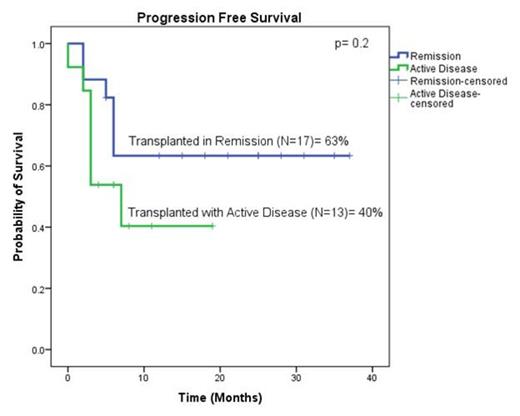Abstract
Background
Haploidentical stem cell transplantation (HaploSCT) is an acceptable option for younger patients (pts) with advanced hematological malignancies without a human leukocyte antigen (HLA)-matched donor; however, it remains unclear whether older pts would benefit from such a transplant. Here, we report the outcomes of pts age 55 years or older who received a T-cell–replete HaploSCT with a reduced-intensity conditioning regimen using fludarabine-melphalan and post-transplant cyclophosphamide (PTCy) as previously described by us.
Methods
We retrospectively analyzed data from 30 pts (20 [67%] with acute myeloid leukemia [15 with high-risk disease], 4 [13%] with myelodysplastic syndromes, 3 [10%] with lymphoma, and 3 with other diagnoses) who received their first HaploSCT between 2009 and 2014. Twenty-one pts (70%) received conditioning with fludarabine 40 mg/m2 (Days -6, -5, -4, -3) and melphalan 100 mg/m2 (Day -8) with thiotepa 5 mg/kg (Day -7) or 2 Gy total-body irradiation (FM100). Nine pts (30%) received a higher melphalan dose of 140 mg/m2. GVHD prophylaxis consisted of PTCy 50 mg/kg on day +3 and +4 after HaploSCT and tacrolimus and mycophenolate for 6 and 3 months, respectively. Sixteen pts (53%) were in remission at the time of transplant. Donors were children (83%) and siblings (17%). All patients but 1 received bone marrow as a stem cell source.
Results
Thirty pts (57% men) with a median age of 61 years (range, 55-69 years) received a HaploSCT between 2009 and 2014. One pt had early death on day +7 from a viral infection. All other pts engrafted successfully (100% engraftment), with 84% achieving 100% donor chimerism at day 30. The median times to ANC and platelet recovery were 19 days (range, 13-27 days) and 28 days (range, 19-46 days), respectively. CMV reactivation occurred in 21 pts (70%) and was treated preemptively. The rates of grade II-IV and III-IV acute GVHD at day 100 were 30% and 10%, respectively; chronic GVHD occurred only in 3 pts (10%) (2 limited, 1 extensive). After a median follow-up duration of 18 months, 18 pts (60%) were alive and disease-free. The 1- and 2-year overall survival rates were 60% and 55%, respectively (62% for pts in complete remission and 41% for pts with active disease at 2 years, log-rank= 0.23), and the 1- and 2-year progression-free survival rate was 55% (63% at 1 and 2 years for pts in complete remission and 40% for pts with active disease at 1 year) (Figure). The 100-day and 2-year cumulative incidences of non-relapse mortality were 17% and 21%, respectively (12% and 18%, respectively, for pts in remission at transplant). Causes of death included relapsed disease (n=6), infection (n=3), chronic GVHD (n=1), and regimen toxicity (n=1).
Conclusions
HaploSCT for older pts up to age of 70 years is associated with low rates of acute and chronic GVHD, acceptable NRM, and excellent survival. Age alone does not appear be a barrier against successful transplantation from a haploidentical donor and should be offered to all pts in need of a transplant without an HLA-matched donor.
No relevant conflicts of interest to declare.
Author notes
Asterisk with author names denotes non-ASH members.


This feature is available to Subscribers Only
Sign In or Create an Account Close Modal